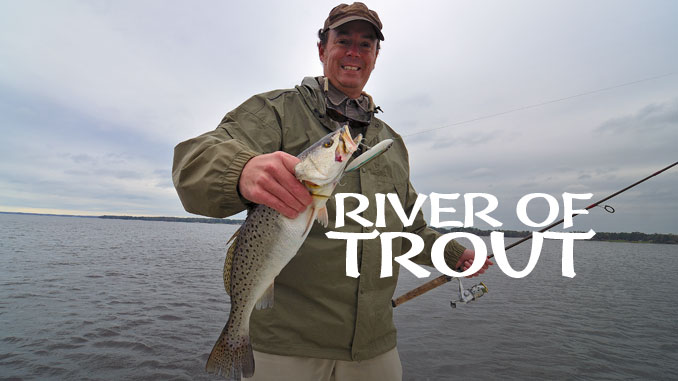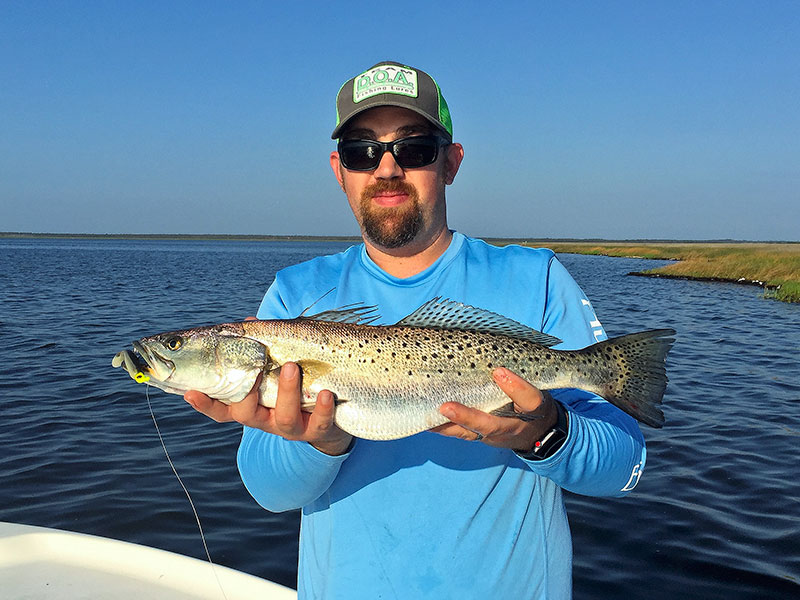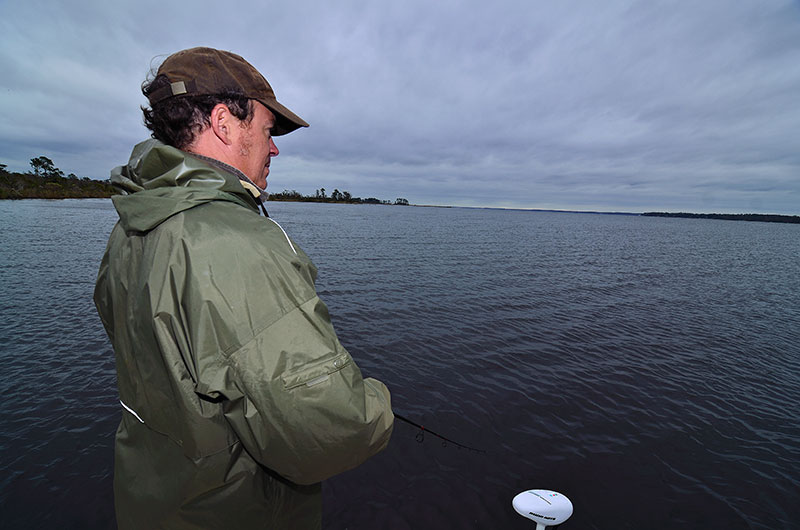
Neuse River provides hot speck action throughout fall
The sweltering summer heat has ended, and the fall fishing frenzy is finally here, bringing cool weather and big smiles to the diehard speckled trout followers. And the waters of the Neuse River are an ideal place to set up camp for consistent fall action.
The Neuse is one of the primary arteries dumping nutrient-rich waters into the 3,000-square mile Albemarle-Pamlico Sound system. It’s the nation’s second-largest inland estuary, behind only the Chesapeake Bay.
Out of the 17 river basins in North Carolina, the Neuse is the longest river that begins and ends within the state’s borders. It empties into the Pamlico Sound just east of Oriental. But prime speckled trout waters continue well upriver, as far inland where the river shrinks along its banks near New Bern.
Dave Stewart of Knee Deep Custom Charters is based out of Minnesott Beach on the river’s northern shore, halfway between New Bern and the Pamlico Sound. October is the beginning of his best speck fishing of the year. That’s when water temperatures drop, and fish begin to move up the river as part of their annual cycle.

Neuse River is home to lots of resident trout
“Most of the speckled trout in our waters are resident fish. They don’t seem to migrate like many of the other speckled trout fisheries up and down the eastern seaboard,” Stewart said. “These fish don’t migrate per se. They make a big loop inside. They spawn on the rocks in the Pamlico Sound during the summer and overwinter up the river and in the inland creeks in deep water.”
Water temperature is the major driving factor for fish movement. It affects both movement of bait and of speckled trout themselves. Specks begin to move out of the sound and head up the river toward their wintering grounds when the fall cool down begins.
“The inland creeks may be their future destination. But they take their time getting to their wintering holes and stage up, concentrating in schools along the river’s edge and in the creek mouths,” he said.
Stewart concentrates on any of the creeks between Minnesott Beach and New Bern: Slocum, Northwest, Upper Broad and Baird creeks, plus the South River. Places with deeper water and structure along the river and inside the creeks offer the best options to find a school of fish. The areas with the most bait will be key.
Look for bait and structure
“Trout congregate around places abundant with bait,” Stewart said. “Go to the shorelines near the creek mouths and into the creeks to look for bait. Most of the trout will not be in the backs of the creeks yet. But there will be a steady flow of fish coming into the creeks to feed this time of year. Work the cuts and coves near the mouth. And places with structure will almost always have some fish in the fall.”
Structure along the river isn’t as common as in many of the tidal regions along the oceanfront communities. But any docks and wooded shorelines with more than 3 feet of water present a prime opportunity to find a school of fall specks.

Since trout are moving in schools and exhibiting staging behavior, creek channels can also be good options to find them.
“Don’t just beat the banks and shorelines. Check out the center of these channel,” Stewart said. “We often get on a solid bite right in the center of the creeks in the deepest parts.”
Lots of options
The menu is full for specks in October and November, with the year-round menhaden being joined by mullet and shrimp. With a variety of forage options available, few lures will fail to get the job done. But some options are better than others.
Stewart typically matches the hatch, using lures that produce solid results when he encounters a school of hungry specks.
“My first choice is always going to be a light jig with a 3- or 4-inch D.O.A shadtail or the 2 3/4-inch D.O.A. shrimp,” he said. “These baits are going to trigger a strike, can imitate all of our forage in the area and can be fished in a variety of water conditions.”
Go as light as possible
Since this part of the estuary lacks current, heavy jigheads aren’t required. Stewart will typically use a 1/8- or 3/16-ounce model. He’ll use shrimp imitations through the fall and early winter, then use jigs with other trailers all winter to imitate the bait available in the area.
“I fish both jigs and shrimp close to the bottom, twitching them along,” he said.
Speckled trout rely on their keen eyesight for foraging. Since the Neuse and its tributaries are tannic, with tea-colored waters, the preferred color palate may differ significantly than in places with clear, green water. Lure color is important to increase visibility and certain colors are more discernable than others in the tea-colored waters of the Neuse River estuary.
“As a general rule, a mixture of gold and red is the best choice,” Stewart said. “But one of my new favorites is candy corn. It’s orange and yellow, and the fish love it around here.”
Target stump fields
Typical speckled trout habitat usually includes oyster beds, sandbars, jetties and maybe a few docks in the mix. But there are places in coastal North Carolina where those preferred habitats don’t exist.
Where those habitats are not available, it doesn’t mean the speckled trout don’t live here. Specks seek out any type of habitat that offers places to hide from predators and ambush their next meal.
Along the Neuse and its tributaries, shorelines that were formerly forested are prime places to tackle a big trout and often, plenty of them.

The old stump fields are a solid opportunity for Dave Stewart of Knee Deep Charters in Minnesot Beach.
“The stump fields near New Bern — we call the Live Oak Point area — are typically fished heavily for rockfish in the fall. But some big trout will hold in these areas, too, because of the abundance of bait,” Stewart said. “It’s not uncommon to be fishing for rockfish in October and find some 4- to 5-pound trout mixed in.”
These stump fields are rather extensive, with stumps in 4- to 7-foot depths. Weedless lure options are preferred in these areas. Stewart likes to use the D.O.A Deadly Combo with a jig or 2 3/4-inch shrimp suspended right in the middle of the stumps. He will also use a 5/0 screw-lock hook with a pinch weight and 4-inch jerk shad to work the bottom.
Finally, a topwater option can be very deadly in this habitat.
“You can use the topwater of your choice, and you can find some bigger fish this way too,” he said.
_____________________
DESTINATION INFORMATION
HOW TO GET THERE — Boat ramps on the Neuse are scattered throughout the region, off tributaries and the river itself. Three popular public ramps are Oriental’s Green Creek Landing near the mouth of the river, Dawson Creeek on the north shore and Hancock Creek along the south shore. For a complete list, visit www.ncwildlife.org/Boating_Waterways/Boating_Maps_Locations.htm
WHEN TO GO — The fall topwater trout bite begins in September and lasts until the water temperature falls into the 50s.
BEST TECHNIQUES — Artificial lures that imitate shrimp, mullet or menhaden are great choices for fall trout. Most fish will be near the bottom or in the lower half of the water column. Retrieve lures slowly, a few feet off the bottom, using a stop-and-go cadence. Jigheads dressed with 3- to 4-inch DOA shrimp, shadtails and jerk shad/soft plastic combos work, as do suspending MirrOlures and topwaters. Since the Neuse’s waters are tea-colored, reds, golds and yellows are preferred lure colors. Fish 14- to 20-pound with a 20-pound fluorocarbon leader on a 61/2- to 7-foot, medium to medium-light spinning outfit,
FISHING INFO/GUIDES — Dave Stewart, Knee Deep Custom Charters, 252-249-1786, www.pamlicotackle.com; George Beckwith, Down East Guide Service, 252-671-3474, www.pamlicoguide.com. See also Guides & Charters in Classifieds.
ACCOMMODATIONS — Visit Oriental, www.visitoriental.com; Visit NC, www.visitnc.com; Terri McManus Vacation Rentals, www.vrbo.com/245297.
MAPS — Capt. Segull’s Nautical Charts, 888-473-4855, www.captainsegullcharts.com;The Salty Southeast Cruising Guide (www.cruisersnet.net/cruisersnet-marine-map/?ll=35.5593,-76.4663&z=14); N.C.’s Coastal Boating Guide (www.ncwildlife.org/Boating_Waterways/documents/NCCoastaBoatingGuideMap.pdf)



Be the first to comment